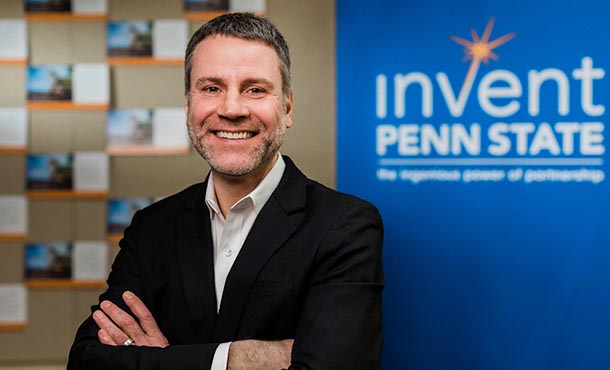
Penn State Professor of Architectural Engineering Kevin Houser is the founder of Lyralux.
Lyralux lights the way for its Dim to Vivid commercial lighting technology
9/20/2018
UNIVERSITY PARK, Pa. — Have you ever noticed that colors start to fade and blend together at lower light levels? Due to how our eyes process color, the dimmer the light source, the less vivid a color appears. This can be a particular challenge for people trying to distinguish colors in low lighting environments like museums and restaurants. Fortunately, Penn State Professor of Architectural Engineering Kevin Houser has developed a technology at Penn State and formed a startup, called Lyralux, to solve this problem.
The patent-pending technology, Dim to Vivid, is a light source technology with a highly engineered variable spectrum that works by differentially adjusting varying LEDs, which emit different colors of light. The light — or spectra — can be effectively “tuned” to compensate for the way people see and recognize colors at fluctuating light levels.
According to Houser, ordinary commercial lighting is not tuned to how the human visual system works under low light conditions.
“Objects that appear vivid and colorful at high light levels become muted and shift toward gray at low light levels,” he said. “Imagine carrying a bright red book from outside in the sunlight into a dimly lit theater — the color changes dramatically.”
Museums are perfect customers for the technology due to their need to have low light levels to protect artifacts. While things like stone sculptures are resistant to the effects of light damage, other artifacts like textiles, painted canvases, and painted wood carvings are susceptible to permanent color fading if overexposed to light.
Lyralux’s first product will be a PAR38 lamp with Dim to Vivid technology that it hopes will be an excellent solution for museum lighting. Currently, galleries with light-sensitive artifacts set their interior lighting at low levels to help protect exhibits from light damage, but as a result, this distorts the perception of colors for visitors. Another common method of protecting items from light damage is to use orange filters on the light sources. Orange filters remove the blue part of the spectrum, which is the most damaging, but create color distortion, as the objects now have an orange tint. The PAR38 solves this problem.
Lyralux and Dim to Vivid have gained attention in the Penn State entrepreneurial community. The startup was selected as a finalist to pitch in the Tech Tournament at the Invent Penn State Venture & IP Conference in April and was part of Ben Franklin Technology Partners TechCelerator@State College spring 2018 cohort. At the end of the TechCelerator program, the entrepreneurs got to pitch their business concepts to a panel of judges for a chance to win up to $10,000 in prizes. Houser presented to the judges, who were so impressed they awarded Lyralux the entire $10,000.
Houser has a long history researching and developing lighting equipment that started at Penn State, where he received his bachelor's degree and doctorate in architectural engineering. From there Houser joined the University of Nebraska-Lincoln faculty, where he was a founding member of Nebraska's architectural engineering program. In 2008, Houser returned to join the faculty at Penn State, which has the oldest continuously accredited architectural engineering program in the United States.
While Lyralux’s first product will be the PAR38 lamp, that’s just the starting point. Lyralux is developing its technology platform for different form-factors and control algorithms, and would like to develop a range of lamp types, light-engines and luminaires designed for applications that will benefit from the technology. The technology could eventually be deployed in entertainment venues, houses of worship, and private residences.



